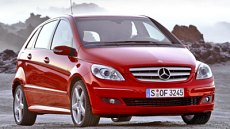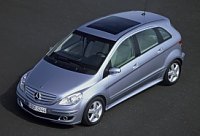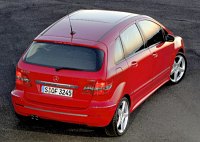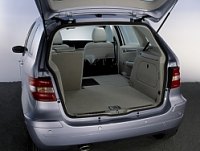|
 Although
Mercedes prefers to call it “Compact Sports Tourer”, the B-class
is actually an enlarged version of A-class, targeting at the MAV
(Multi-Activity Vehicle) market. It will be therefore seen as a
premium alternative to Renault Scenic, Ford C-Max, VW Touran etc. Although
Mercedes prefers to call it “Compact Sports Tourer”, the B-class
is actually an enlarged version of A-class, targeting at the MAV
(Multi-Activity Vehicle) market. It will be therefore seen as a
premium alternative to Renault Scenic, Ford C-Max, VW Touran etc.
The
A-class platform has all the necessary ingredients to form the basis
of a MAV. First of all, it is the only front-drive,
transverse-engined platform in Mercedes' lineup. Secondly, its
sandwich chassis structure allows even higher space efficiency than
other MAVs, because the cabin can be stretched forward without being
blocked by the engine. Thirdly, the elevated floor and sitting
position meets exactly the requirements of MAVs. Lastly, as the
sandwich structure has the engine mounted lowly and the fuel tank and
battery under the floor, its center of gravity is lower than regular
MAVs. This means Mercedes can tune the suspensions softer yet
provides higher resistance of body roll.
 Basically,
the B-class is a stretched version of A-class, despite of a different
series name. While the increase of body width is just 13 mm, the
wheelbase is stretched by 210 mm and the overall length grows 430 mm.
This stretched the cabin length to an astonishing 2989 mm or 70% of
the body length. No one else can match this space efficiency. Basically,
the B-class is a stretched version of A-class, despite of a different
series name. While the increase of body width is just 13 mm, the
wheelbase is stretched by 210 mm and the overall length grows 430 mm.
This stretched the cabin length to an astonishing 2989 mm or 70% of
the body length. No one else can match this space efficiency.
The
advantage continues here: rear legroom now grows by 370 mm (it's
limousine class !); luggage space increases to 544 litres from 435
litres; with the rear seat folded and the front seat removed, it can
load 2245 litres, up from 1995 litres. Brilliantly, all these
increments bring only an additional 75 kg to the kerb weight, so the
B-class can employ the same engines as A-class without much deficit
in performance.
 Compare
to other MAVs, the cabin of B-class is relatively less flexible. Its
rear seat can fold flat but not slide. Admittedly, with 544 litres of
luggage space right from the beginning, sliding becomes less crucial.
Another thing it lacks is a third row of seat for carrying children.
Mercedes simply has no interest to sell a people carrier. Compare
to other MAVs, the cabin of B-class is relatively less flexible. Its
rear seat can fold flat but not slide. Admittedly, with 544 litres of
luggage space right from the beginning, sliding becomes less crucial.
Another thing it lacks is a third row of seat for carrying children.
Mercedes simply has no interest to sell a people carrier.
The
B-class is produced alongside A-class at the Rastatt plant. It shares
all the engines bar the smallest diesel with its sister. That means
it consist of B150 (95hp), B170 (115hp), B200 (136hp), B200 Turbo
(193hp), B160CDI (109hp) and B200CDI (140hp). It also shares the same
transmissions – Autotronic CVT, 5-speed manual and 6-speed manual.
On
the road, the B-class feels more lively than other MAVs. Take the top
model B200 Turbo for example, it has 193 horsepower and a strong 207
lbft of torque to pull just 1370 kg. Not even the previous Opel
Zafira OPC can match its sparkling performance – it can sprint from
rest to 60 mph in 7.3 seconds and reach a top speed at 140 mph. This
is simply a GTI ! The rich torque curve gives B200 Turbo incomparable
flexibility too. It delivers all that 207 lbft from as little as 1800
rpm all the way to 4850 rpm ! You don't need to rev the engine hard to
deliver performance (by the way, the engine is a bit noisy and
unrefined at high rev due to the lack of balancer shafts). Leave it at
high gear and
the torque will do the work for you.
 Thanks
to the superior chassis, B-class handles and rides remarkably well by
MAV standard. It feels more agile than most MAVs. Only Ford C-Max can
have a fight, but then again the Mercedes rides more supple. If you
like the ride of A-class, you will love B-class even more, because
its longer wheelbase improves ride quality further. Both cars have
the same electric power steering which provides decent feel. Both
cars can opt for mechanical adaptive dampers to enhance body control. Thanks
to the superior chassis, B-class handles and rides remarkably well by
MAV standard. It feels more agile than most MAVs. Only Ford C-Max can
have a fight, but then again the Mercedes rides more supple. If you
like the ride of A-class, you will love B-class even more, because
its longer wheelbase improves ride quality further. Both cars have
the same electric power steering which provides decent feel. Both
cars can opt for mechanical adaptive dampers to enhance body control.
Predictably,
the B-class is more expensive than other mainstream MAVs. What you
get in return is a better handling and ride combination, better
performance, a roomy cabin for 5 people and the overall premium
quality feel. Look at the high quality dashboard and console (same as
A-class) and you will understand. |